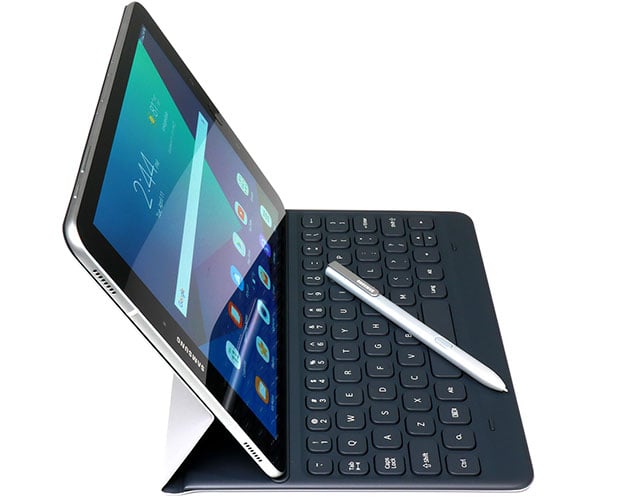Samsung Galaxy Tab S3 Review: Premium Android Productivity And Entertainment
Samsung Galaxy Tab S3 - Design
To give the Galaxy Tab S3 a seamless look, Samsung used glossy, reinforced glass panels affixed to an aluminum frame with smooth, rounded edges. The tablet comes in silver or black, and both colors look sharp to our eyes. We had the silver version on hand for testing. In addition to looking the part of a premium tablet, we were pleased with the fact that this color option doesn’t seem to attract fingerprints on the back panel. Although we didn’t have a problem gripping the tablet, the smooth finish on the back can get a little slippery at times.
On the top edge of the Galaxy Tab S3, you’ll find two speaker grills, one in each corner. The right edge of the tablet contains a Power/Wake button, volume rocker, and a microSD card slot which requires a paperclip or key to open. You’ll find the keyboard connection on the left edge of the Galaxy Tab S3. A headphone jack and USB-C port are located along the bottom edge between two speaker grills.
Above the display to the right of the Samsung logo, you’ll find a 5-megapxiel front-facing camera. Below the display in the bezel of the tablet you’ll find the Home button which also contains a fingerprint scanner. During our tests, the fingerprint scanner worked well and was quick to unlock the tablet. Traditional Android Application and Back buttons are located on either side of the Home button, right where you'd expect them. These buttons will illuminate when pressed. The glossy screen will attract some fingerprints, but it didn’t seem to hamper the use of the tablet. While viewing angles on the Galaxy Tab S3 are very good, glare occasionally makes it hard to view the screen.
The back glass panel of the Galaxy Tab S3 gives it a richer look than previous generation tablets that utilized a textured or smooth plastic. Although we really like the look of this tablet, the premium materials used on the back panel becomes less important when it’s covered up by a case, which often happens. A 13-megapixel rear camera with auto focus is located near the top of the back of the tablet, which works well (more on this later), but we should not that when the optional keyboard case is attached, it covers the rear-facing camera.
The Galaxy Tab S3 has four stereo speakers tuned by AKG by HARMAN, one in each corner of the tablet. These speakers have an “Auto Rotate Stereo” function that will redirect the sound based on the tablet's orientation. Indeed, when we rotated the tablet the stereo channels rotated with the orientation of the screen. Though the audio output on this device is better than most other tablets, we were ultimately disappointed in the fullness of sound from the Galaxy Tab S3. More specifically, lows were lacking significantly. This is to be expected considering how tiny the drivers are, but we wanted to point out the lack of bass output nonetheless.
Samsung gets bragging rights for offering one of the first HDR (high dynamic range) tablets on the market. HDR promises an increased range of color and better contrast to give you a more vivid picture. This feature comes with the caveat that HDR content is currently very limited – we’re waiting on providers such as Amazon and Netflix to update their mobile apps to offer this content on the Tab S3. Even so, this tablet is ready to take advantage of the HDR content as soon as it becomes available. In the meantime, you’ll still have a super-crisp and colorful display to enjoy movies and other content thanks to the Galaxy Tab S3’s Super AMOLED screen, which allows for richer colors and deeper blacks compared to the IPS LCD panels used on some other tablets.
Although we’re waiting on HDR content to become widely available for tablets, the HDR-ready screen found on the Galaxy Tab S3 makes it slightly more future-proof than some of its competitors such as the similarly priced 9.7-inch Apple iPad Pro, which doesn’t currently offer a HDR-ready screen but does offer the same screen resolution of 2048-by-1536.











